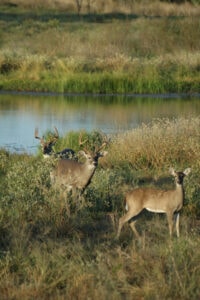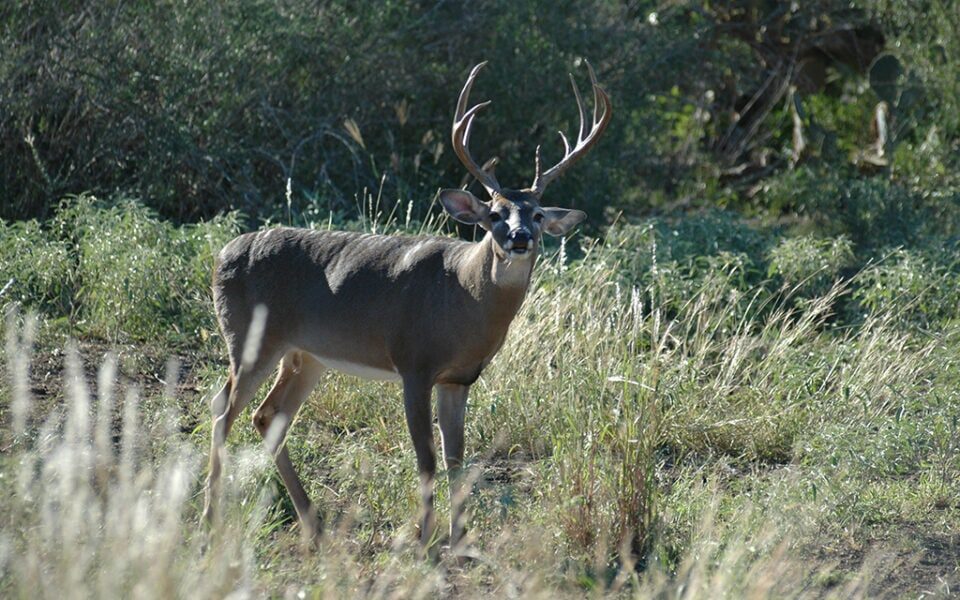Deer hunters have their own lexicon, a list of deer hunting terms unique to the activity. Most hunters are familiar with them and use them fluently, but some don’t have a full understanding of what they really mean, and how to properly use them.
Home Range
There’s a couple terms, and definitions about where deer live that are worth understanding correctly. One is home range. Most hunters are familiar with it but do you really know what it means? Biologists define a whitetail’s home range as the geographic area within which it spends 90 percent of its time over the course of a year.
Ask most any knowledgeable hunter and they’ll tell you a deer’s home range is roughly a square mile. That’s not necessarily true. Home range size can vary considerably based on things like herd density, habitat and food availability. In prime areas with good food and nutrition, a deer’s home range could be a quarter of that. Where food, water, cover or a suitable mate are lacking, it might be 4 or 5 times that. However, if you average them all out it does fall roughly around a square mile.
Within that home range is a smaller core area, defined as where a deer spends more than 50 percent of its time during the year. This might be a little misleading as 50 percent is less than 90 percent. But remember, it’s evaluated over a year’s time. If you put a satellite transmitter on a buck, recorded its location on a daily basis and plotted all the points you can remove 10 percent, usually during excursion events, and you get home range. Now look at where, within that home range the deer spent more than half of its time and you get the core area. This is where you’re most likely to find that deer on any given day, and it’s usually a lot smaller than a square mile. The rub – no pun intended – is figuring that out.
Whitetail Deer Age Class
 Age is another area where confusion sometimes occurs. Everyone knows what fawns are, but as they grow older and bigger, and enter their first fall hunting season they’re sometimes referred to as yearlings. A yearling is a deer that’s at least one year old, meaning it would be entering its second hunting season. If it’s a buck it will probably sport antlers; maybe spikes or fork horns, but usually a very obvious set of bones.
Age is another area where confusion sometimes occurs. Everyone knows what fawns are, but as they grow older and bigger, and enter their first fall hunting season they’re sometimes referred to as yearlings. A yearling is a deer that’s at least one year old, meaning it would be entering its second hunting season. If it’s a buck it will probably sport antlers; maybe spikes or fork horns, but usually a very obvious set of bones.
For the next few years, biologists and a good many hunters might say a buck is 2-1/2 or 3-1/2. I never quite understood why we had to add the fraction. First, everyone knows, and the only time it might really matter is if it’s a yearling and you’re trying to decide if it’s a year and six months or a year and seven months, based on tooth wear and replacement. If someone asks your age to you add the months as well? No; you give the same answer whether you just had a birthday or its 11 months away.
Maturity is another term that sometimes gets misused. By strict definition, it’s the point at which an organism ceases growing, physically. Some humans take longer to mature than others, behaviorally, especially guys. But like deer, we reach a point where the growth of our skeletal structure ceases. They, and we, may continue to put on weight, but we don’t really grow. In deer, this occurs in their fourth year. So a mature buck is at least 4-/12, or just 4, but not 3-1/2. The latter may look big but they still have some growing to do. Once body growth ceases, more resources can be distributed to antler growth, which is why there’s often a big jump between ages 3 and 4.
Rut Phases
Perhaps the greatest area of misinformation about whitetails involves so called phases of the rut: seeking, chasing, breeding, etc. They do occur, but not as discreetly as we would like to believe. It’s human nature to try and label and categorize things into distinct and separate categories, but nature itself doesn’t work that way.
The seeking phase is when a buck is out and about and looking for love. Incidentally, this is often when they go on excursions, leaving both their core area and home range in search of a potential mate. Chasing occurs when they find one, and if all goes well, breeding follows. Unfortunately, this doesn’t all happen based on calendar dates.
Yes, it’s guided by daylight, and yes, most adult does will come into estrus in a relatively narrow, roughly 10-day window. But like home range, that’s based on an average. Some does may be ready to breed a month earlier, or not ready until a month later. Even within that peak period there’s quite a bit of variability. One buck may still be seeking while another, on the same property is chasing a hot doe, and yet another has escorted a receptive female off to some secluded area. I have literally witnessed all three phase behaviors in the same food plot on the same day.
Speaking of the rut, that’s another term that sometimes leads to confusion. When someone asks, “Are they rutting yet?” or “Is the rut on?” they usually mean are the bucks chasing and breeding. However, “rut” includes all behavior associated with mating. It starts with scraping to leave a scent signal and perhaps attract a mate, which is sometimes referred to as pre-rut. It spans the chasing “phase,” when bucks are starting to approach and harass does that may still not be ready, and culminates with breeding. Peak rut, which is when most bucks are actively moving during daylight doesn’t necessarily coincide with peak breeding. In fact, the former usually precedes the latter, and peak breeding can sometimes be a bit of a lull in deer activity.
Conclusion
These are just a few examples and in the overall analysis, what terms you ascribe to different periods, phases, ages or behaviors may not really matter so long as you know what’s going on and how to respond as a hunter. Still, it does make for a good debate in hunting camp.
Join our weekly newsletter or subscribe to GameKeepers Magazine.
Your source for information, equipment, know-how, deals, and discounts to help you get the most from every hard-earned moment in the field.








